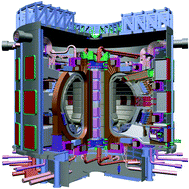Plasma–surface interaction in the context of ITER
Abstract
The decreasing availability of energy and concern about climate change necessitate the development of novel sustainable energy sources. Fusion energy is such a source. Although it will take several decades to develop it into routinely operated power sources, the ultimate potential of fusion energy is very high and badly needed. A major step forward in the development of fusion energy is the decision to construct the experimental test reactor ITER. ITER will stimulate research in many areas of science. This article serves as an introduction to some of those areas. In particular, we discuss research opportunities in the context of plasma–surface interactions. The fusion plasma, with a typical temperature of 10 keV, has to be brought into contact with a physical wall in order to remove the helium produced and drain the excess energy in the fusion plasma. The fusion plasma is far too hot to be brought into direct contact with a physical wall. It would degrade the wall and the debris from the wall would extinguish the plasma. Therefore, schemes are developed to cool down the plasma locally before it impacts on a physical surface. The resulting plasma–surface interaction in ITER is facing several challenges including surface erosion, material redeposition and tritium retention. In this article we introduce how the plasma–surface interaction relevant for ITER can be studied in small scale experiments. The various requirements for such experiments are introduced and examples of present and future experiments will be given. The emphasis in this article will be on the experimental studies of plasma–surface interactions.


 Please wait while we load your content...
Please wait while we load your content...